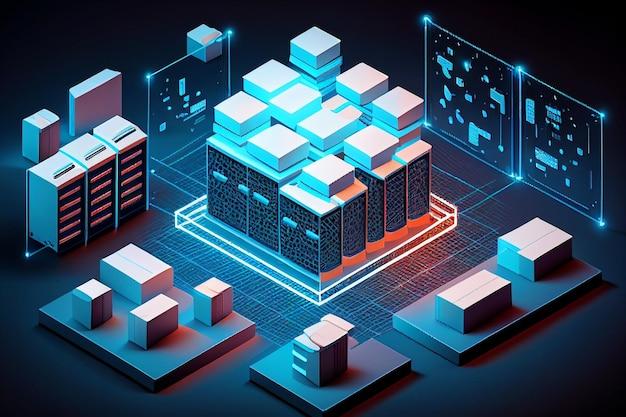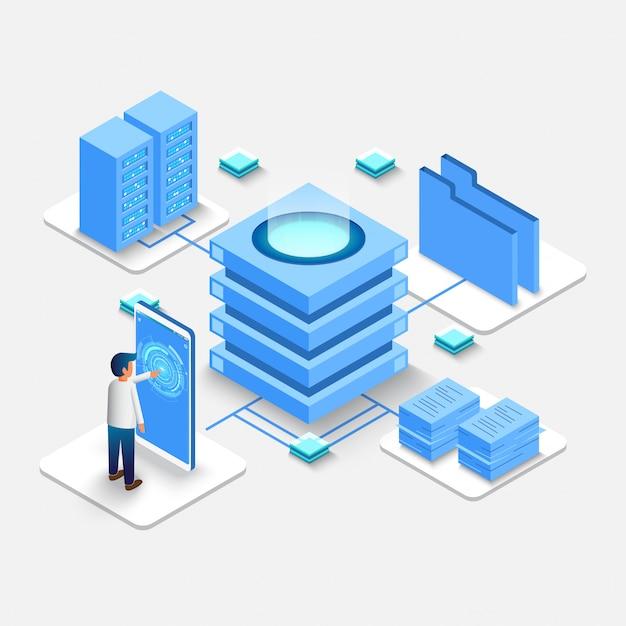Are you looking for a modern data architecture that can handle the complexities of today’s data environment? Look no further than the data fabric architecture!
As the amount and types of data continue to grow, traditional data architectures are struggling to keep up. That’s where the data fabric architecture comes in. It’s a comprehensive framework designed to integrate data from various sources and locations into a unified and consistent view.
But what are the principles that underpin the data fabric architecture, and how does it differ from other types of data architecture? In this blog post, we’ll dive into these questions and more. We’ll explore the key concepts behind data fabric architecture, including data virtualization, automation, and self-service.
We’ll also take a closer look at the differences between data architecture and data management. While these terms are often used interchangeably, they actually describe two different aspects of the data environment. Data architecture refers to the design and structure of data, while data management involves the day-to-day operations of managing and maintaining data.
So, what exactly is the data fabric architecture, and how can it help organizations adapt to the rapidly evolving data landscape? Keep reading to find out!
Data Fabric as Modern Data Architecture
Data fabric is a modern data architecture that enables businesses to unify their fragmented data sources by creating a single, unified environment for data integration, management, and analysis. It is designed to support multiple data types and workloads across hybrid and multi-cloud environments.
Why Use Data Fabric
Data fabric provides several advantages for businesses that are dealing with the complexity of modern data architecture. By providing a unified view of data, it enables organizations to make data-driven decisions more quickly and accurately. Data fabric also helps businesses address issues related to data security, data governance, and compliance. Moreover, it helps organizations become more agile and adaptable to change by providing them with the ability to access and analyze data from various sources.
How Does Data Fabric Work
Data fabric works by creating an abstracted and centralized layer that allows businesses to manage data across the entire organization. It provides a single point of control for data access, governance, and analytics. Data fabric utilizes modern technologies such as machine learning, artificial intelligence, and automation to manage and optimize data. With data fabric, organizations have a more scalable and resilient data management infrastructure that is better able to handle the demands of modern business.
Benefits of Data Fabric
Data fabric provides several benefits to businesses, including:
-
Seamless Data Integration: Data fabric provides seamless integration across different data sources, enabling businesses to bring together data from various sources in a unified environment.
-
Improved Data Quality: Data fabric enables businesses to maintain data quality by providing a single point of control for data governance and data management.
-
Increased Business Agility: Data fabric makes it easier for businesses to adapt to change by providing a flexible data management architecture that can quickly adapt to new sources of data.
-
Enhanced Data Security: Data fabric provides a secure data management environment that helps organizations comply with data privacy regulations and safeguard sensitive information.
In conclusion, data fabric is a modern data architecture that provides a unified approach to data management, integration, and analysis. By leveraging data fabric, businesses can enhance their data management capabilities, improve data quality, and increase their agility in adapting to change.
Data Fabric Principles
Data fabric is a modern data architecture that provides an integrated and unified view of data across multiple sources and locations. It enables organizations to manage, process, and analyze data more efficiently and effectively. Here are some of the principles that define data fabric:
Integration
Data fabric integrates data from various sources such as databases, data lakes, and cloud services, making it easy for organizations to access and utilize their data. This integration reduces data silos and enables organizations to make better decisions based on a comprehensive view of their data.
Agility
Data fabric is designed for agility, enabling organizations to quickly adapt to changes in data sources, technologies, and business needs. It provides a flexible framework that can easily accommodate new data sources and can scale to support growing data volumes.
Automation
Data fabric automates many aspects of data management, including data discovery, data mapping, metadata management, and data lineage. This automation reduces manual effort, saves time, and increases accuracy.
Invisibility
Data fabric operates invisibly, abstracting the complexities of data management from business users. This invisibility enables business users to access and utilize data more easily, without requiring technical training or expertise.
Security
Data fabric provides security features such as data encryption, access controls, and auditing, ensuring that data is protected from unauthorized access, breaches, and data loss.
Unified Governance
Data fabric enables unified governance of data across the enterprise, providing consistent policies, processes, and controls for data management. This unified governance ensures data quality, compliance, and accountability.
In conclusion, data fabric is a modern data architecture that offers many benefits to organizations looking to manage, process, and analyze their data more effectively. By applying the principles of integration, agility, automation, invisibility, security, and unified governance, organizations can build a comprehensive and scalable data fabric that meets their business needs.
Types of Data Architecture
Data architecture refers to the organization of data according to different systems, environments, and platforms. There are three common types of data architecture, namely:
1. Traditional Data Architecture
This type of data architecture involves storing data in different silos where it can only be accessed by a specific department or application. Each silo typically has its own hardware, software, and protocols, which make it hard to share data between silos. This approach was commonly used in the past, but it has become increasingly outdated due to its rigidity and inefficiency.
2. Modern Data Architecture
Modern data architecture allows data to be stored in a centralized location where it can be easily accessed, processed, and analyzed by different applications and departments. This architecture typically involves the use of a variety of technologies such as cloud computing, distributed data stores, and machine learning algorithms, which can help to improve the speed, reliability, and scalability of data management.
3. Data Fabric Architecture
Data fabric architecture is the latest evolution of modern data architecture. It involves the use of a unified platform that can seamlessly integrate data from a variety of sources, including structured, semi-structured, and unstructured data. The platform also allows data to be processed and analyzed in real-time, making it easier for organizations to extract insights and make informed decisions.
In conclusion, the type of data architecture you choose should depend on your specific needs and goals. Traditional data architecture may be suitable for small organizations with limited data management needs, while modern data architecture and data fabric architecture may be more suitable for larger organizations with complex data requirements.
Data Architecture vs Data Management
As businesses continue to deal with an ever-increasing volume of data, the need for effective data management and architecture becomes more essential. While these two terms are often used interchangeably, they represent two distinct functions within the data world.
What is Data Management
Data management involves the process of ingesting, storing, organizing, maintaining, and using data. It deals with data at its most basic level, attempting to ensure that data is structured in a way that is organized, easily accessible, and protected. The focus of data management is on the management of data throughout its lifecycle.
What is Data Architecture
Data architecture is the design of the data ecosystem that supports data management. It involves the creation of a blueprint that defines data structures, storage formats, protocols, and policies. The goal of data architecture is to ensure that data is organized and stored in a way that allows for efficient use, access, and analysis.
Is One More Important Than the Other
Data architecture and data management are both essential for ensuring that data is effectively managed in modern data ecosystems. While data management deals with the practical aspects of data collection and storage, data architecture lays the foundation for data management to function effectively. Think of it as building a strong house – data architecture provides the framework that supports data management.
In summary, data management and data architecture are two distinct but closely related functions in modern data ecosystems. Data management ensures that data is effectively stored and organized, while data architecture provides the foundation on which data management is built. To be effective in managing data in modern business environments, it is essential to have a clear understanding of both data architecture and data management.
What is Data Fabric Architecture
Data fabric is an innovative, modern data architecture that enables organizations to integrate, manage, and govern data across multiple environments. It aims to provide a single, unified view of data assets, regardless of its location or format. In simpler terms, a data fabric is a platform that facilitates the seamless movement of data between various systems and applications, eliminating the need for manual data integration.
How does Data Fabric Work
Data fabric architecture consists of three main components, namely:
1. Data Integration Layer
This layer forms the core of the data fabric architecture, where data is unified across various sources, formats, and locations. The data integration layer enables the harmonization of data through metadata management, data profiling, and data quality management to ensure a consistent, accurate, and high-quality dataset.
2. Data Management Layer
The Data Management Layer ensures data is governed throughout its lifecycle across the enterprise. It incorporates features that enable data producers to control the data they create and enables data consumers to get access to the data they need. This layer also includes robust security and compliance capabilities to ensure data privacy and integrity.
3. Application Layer
This layer is where the business applications interact with the data fabric to access, analyze, and manipulate data. This layer enables self-service analytics and enables applications to share and consume data in a consistent and efficient manner.
Benefits of Data Fabric Architecture
Data fabric architecture provides organizations with several benefits, including:
- Faster and more efficient data integration and delivery
- Increased data quality and consistency
- Greater visibility and control over data assets
- Improved data governance and regulatory compliance
- Reduced costs and risks associated with data management
- Increased agility to respond rapidly to changing business needs.
Data Fabric has become a vital aspect of a modern data architecture. It provides organizations with the tools they need to embrace digital transformation, enabling them to make data-driven decisions quickly and efficiently. Whether you are a small-scale business or a massive corporation, incorporating data fabric architecture into your data management strategy can be a game-changer.



